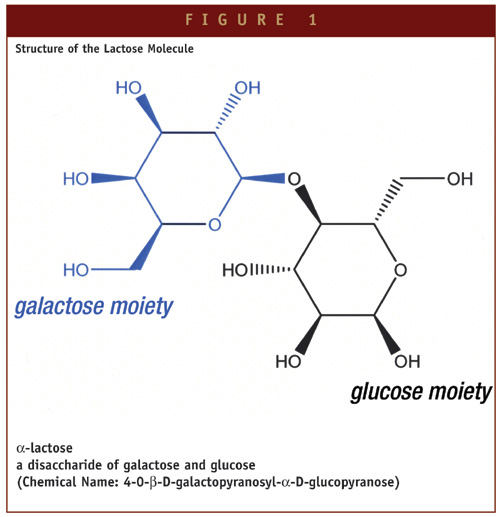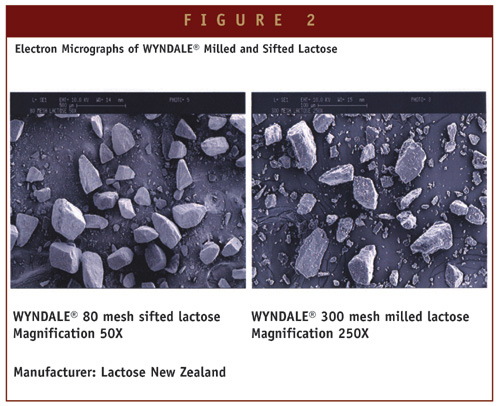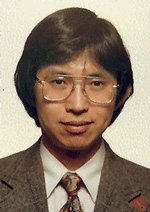Issue:Vol. 4 No. 5 June 2004
Lactose in Pharmaceutical Applications

Pharmaceutical-grade lactose is highly pure lactose specifically produced to meet the standards of identity and purity set down in the lactose monographs of the various pharmacopoeia, including the United States Pharmacopoeia/National Formulary (USP/NF). Lactose is widely used as a filler or diluent in tablets and capsules, and to a more limited extent in lyophilized products, infant feed formulas, and a diluent in dry-powder inhalations.1-9
GENERAL PROPERTIES OF LACTOSE AS AN EXCIPIENT
Lactose is widely used as a filler or filler-binder in the manufacture of pharmaceutical tablets and capsules. The general properties of lactose that contribute to its popularity as an excipient are its:
- cost effectiveness;
- availability;
- bland taste;
- low hygroscopicity;
- compatibility with active ingredients and other excipients;
- excellent physical and chemical stability; and
- water solubility
Various lactose grades are commercially available that have different physical properties, such as particle size distribution and flow characteristics. The most common form of lactose used in pharmaceutical formulation is crystalline a-lactose monohydrate. This form is available in a range of milled and sifted pharmaceutical grades differing in physical properties, such as flowability, bulk density, and particle size distribution (Figure 2).

Lactose is also available in modified forms for use as a filler-binder in the production of tablets by the direct compression method. The two most important forms for this application are spray dried lactose and anhydrous lactose (Figure 3). These forms have the key property that they are inherently compactable, that is, they are able to form a solid compact (ie, tablet) under compression.

PHARMACEUTICAL APPLICATIONS OF LACTOSE
In order to make tablets or capsules, a blend of excipients and active ingredients must first be prepared. In its final form, as the tablet press or capsule filling feed material, this blend is referred to as the running powder. Three major processes are used to prepare the running powder from its components; these are:
- wet granulation;
- dry granulation or slugging; and
- dry mixing.
For wet granulation, the binder can be added dry to the powder blend, or as a solution in the solvent. The solvent is usually ethanol, water, or a mixture of both. The actual granulation is performed in either a high-shear, or low-shear type mixer. Low-shear granulation requires cheaper equipment and produces a more porous granule. High-shear granulation is faster and affords good control over particle size.
The finer milled grades are commonly used as fillers in the production of tablets by the wet granulation, or in applications in which a small particle size is required. The coarser sifted grades are used when flowability is important, for example, as diluents in capsule and sachet filling applications, and as a flow improver. Some sifted grades are also used as fillers in granulation and direct compression formulations, although they must be used with a binder, as crystalline a-lactose monohydrate has little inherent compactability.
Fluid bed wet granulation is another
variation of the process in which the granulation and drying is carried out in the same vessel (a fluid bed granulator). The powder mix is fluidized by dry air inside a chamber. The binder solution is sprayed onto the fluidized powder to form the agglomerates. Air fluidizing continues until the agglomerates are dry. The process requires expensive equipment, but is simpler and produces a very porous low-density granule, which can result in faster drug dissolution. Slow drug dissolution is sometimes a problem associated with wet granulation, as the active ingredient is locked into the granule, and initial tablet disintegration liberates the granules rather than the primary drug particles.
In dry granulation, particle size enlargement is achieved by aggregating the powder particles under high pressure (ie, by compaction) then milling the compressed material to the desired size. Fines generated by milling are recycled back through the compactor. The compression step is typically carried out in a roller compactor in which the powder is compressed between two rollers.
In direct compression, the key running powder requirements (principally blend homogeneity, consistent bulk density, flow, and compactability) must be met by the dry blend of excipients as there is no further physical or chemical modification before tableting. Thus, the physical and functional properties of the excipients, particularly the filler-binder, are very important and must be consistent from batch to batch.
Anhydrous lactose for direct compression is usually produced by drying a lactose solution on the surface of a heated drum. This results in a product composed of agglomerated small crystals of anhydrous b-lactose, with some anhydrous a-lactose present. The anhydrous product has excellent compactability and high solubility due to its high b-lactose content. Tables 1 through 4 are examples of direct compression tablet formulations that use a highly compactable lactose powder composed of agglomerated micro-crystals of anhydrous beta-lactose and stable anhydrous alpha-lactose as a filler-binder.

SUMMARY
Generally, the grade of lactose chosen is dependent on the type of dosage form being developed. In addition to the general properties of lactose, several characteristics of lactose will be beneficial to the pharmaceutical formulations if the lactose could offer BSE-free status, very high purity / low protein residue, excellent functionality, special modified forms for direct compression applications, and Calf Rennet Free pharmaceutical lactose.
______________
REFERENCES
- Zuurman K, Riepma KA, Bolhuis GK, et al. The relationship between bulk density and compactibility of lactose granulations. Int J Pharm. 1994;102:1-9.
- Bernabe I, Di Martino P, Joiris E, et al. An attempt at explaining the variability of the compression capacity of lactose. Pharm Technol Eur. 1997;9(1):42-51.
- Hwang RC, Peck GR. A systematic evaluation of the compression and tablet characteristics of various types of lactose and dibasic calcium phosphate. Pharm Tech. 2001;25(6):54-68.
- Shukla AJ, Price JC. Effect of moisture content on compression properties of directly compressible high beta-content anhydrous lactose. Drug Dev Ind Pharm. 1991;17: 2067-2081.
- Thwaites PM, Mashadi AB, Moore WD. An investigation of the effect of high-speed mixing on the mechanical and physical properties of direct compression lactose. Drug Dev Ind Pharm. 1991;17:503-517.
- Riepma KA, Dekker BG, Lerk CF. The effect of moisture sorption on the strength and internal surface area of lactose tablets. Int J Pharm 1992;87:149-159.
- Çelik M, Okutgen E. A feasibility study for the development of a prospective compaction functionality test and the establishment of a compaction data bank. Drug Dev Ind Pharm 1993;19:2309-2334.
- Lerk CF. Consolidation and compaction of lactose. Drug Dev Ind Pharm. 1993;19: 2359-2398.
- Timsina MP, Martin GP, Marriott C, et al. Drug delivery to the respiratory tract using dry powder inhalers. Int J Pharm. 1994;101:1-13.

Dr. Jian-Hwa Guo is the Senior Sales Manager with additional responsibility as Senior Manager of R&D and Technical Services in the Pharmaceuticals Division of Noveon, Inc. He earned his BS in Pharmacy from Taipei Medical College (Taipei, Taiwan) and his PhD in Pharmaceutics in 1991 from the University of Michigan. Prior to joining Noveon in 1999, Dr. Guo has worked at several pharmaceutical and chemical specialties companies, such as Shionogi, Upjohn, 3M Pharmaceuticals, Lohmann Therapy Systems Corp., and Hercules Incorporated. He also has several years of pharmaceutical sales and business involvement experience in the pharmaceutical areas. His research and business experiences include transmucosal, transdermal, conventional, and polymeric drug delivery systems. He has approximately more than 100 research papers, book chapters, patent applications, and presentation abstracts published in these areas. Very active in the AAPS, Dr. Guo has been a speaker at several annual meetings, has served as Chairs of Pharmaceutical Polymer, Nutraceuticals, and Generic Pharmaceuticals Focus Groups, and actively addressed the polymeric issues in the pharmaceutical product and dosage form developments.
Total Page Views: 85562









